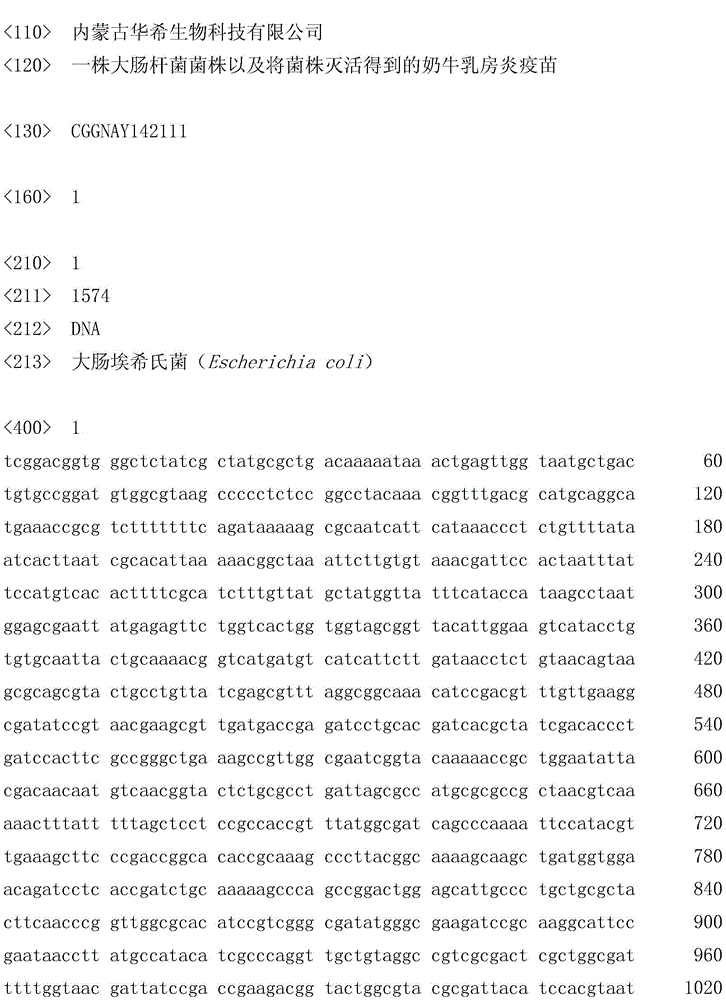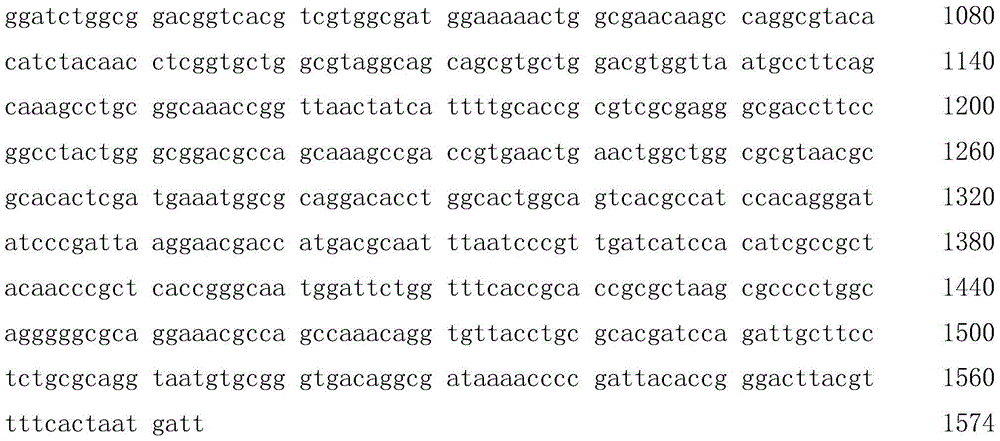A strain of Escherichia coli and a cow mastitis vaccine obtained by inactivating the strain
A technology for dairy cow mastitis and Escherichia coli, which is applied in the direction of bacteria, antibacterial drugs, and methods based on microorganisms, can solve the problems of high actual loss, spread of pathogenic microorganisms, and high attack rate of dairy cows, and achieve the effect of various dosage forms
- Summary
- Abstract
- Description
- Claims
- Application Information
AI Technical Summary
Problems solved by technology
Method used
Image
Examples
Embodiment 1
[0029] Embodiment 1, acquisition and preservation of recombinant bacteria
[0030] 1. Screen wild bacteria
[0031] 30,000 cow milk samples were collected from 90 medium and large dairy farms in 30 provinces and cities including Inner Mongolia, Chongqing, Guangzhou, Heilongjiang, Lanzhou, Hebei, and Shandong. Milk sample collection method of dairy cows: select cows with clinical symptoms of mastitis (or suspected subclinical mastitis), first scrub the udders with warm water, then scrub the udders with 0.2% bromogeramine, and finally wipe the nipples with 70% alcohol. At the same time, use 70% alcohol to wipe and disinfect the fingers. Squeeze out the first 2-3 handfuls of milk from each milk chamber to eliminate contaminated bacteria. Take at least 5mL of milk samples from each cow in a sterile milk sample cup.
[0032] Isolation and purification of Escherichia coli strains from milk samples. Colony morphological characteristics of Escherichia coli (37°C, cultured for 24-72h...
Embodiment 2
[0041] Embodiment 2, the characteristic of bacterial strain EBMO9
[0042] The cryopreservation tube obtained in step 2 of Example 1 was thawed at room temperature, and the P3 generation strain EBMO9 was subjected to the following steps:
[0043] 1. Immunogenicity of strain EBMO9
[0044] Rabbits were immunized with the P3 generation strain EBMO9 (single immunization, each by subcutaneous injection of 5×10 7 CFU / ml, 1 ml for each injection), 21 days later, blood was collected from the heart, and the serum was separated. The IgG antibody titer of the serum was detected by ELISA (serum dilution was obtained by gradient dilution with PBST buffer; the P3 generation strain EBMO9 was used as the coating source, and the coating concentration was 1×10 9 Bacteria / ml; goat anti-rabbit IgG enzyme-labeled secondary antibody; set negative control, that is, replace serum diluent with PBST buffer; detect the absorbance value at 450nm; the absorbance value is more than 2.1 times that of the...
Embodiment 3
[0051] Embodiment 3, the preparation of vaccine
[0052] The cryopreservation tube obtained in step 2 of Example 1 was thawed at room temperature, and the P3 generation strain EBMO9 was subjected to the following steps:
[0053] 1. Take the P3 generation strain EBMO9 and resuspend it with PBS buffer.
[0054] 2. Take the bacterial solution obtained in step 1, add 37-40% formaldehyde solution to make the formaldehyde concentration 0.4% (volume ratio), incubate at 37°C and 150rpm for 36h (36h-48h is acceptable in practical applications), centrifuge (5000r / min, 20min) to collect the bacteria, wash the bacteria with sterilized PBS buffer, and then suspend the bacteria with sterilized PBS buffer to obtain Vaccine-I (containing 1×10 10 bacteria / mL).
[0055] 3. Take vaccine-I, add aluminum hydroxide to make the concentration 0.5 mg / ml, and obtain vaccine-II.
[0056] 4. Take vaccine-I, add aluminum phosphate to make the concentration 0.5 mg / ml, and obtain vaccine-III.
[0057] ...
PUM
 Login to View More
Login to View More Abstract
Description
Claims
Application Information
 Login to View More
Login to View More - Generate Ideas
- Intellectual Property
- Life Sciences
- Materials
- Tech Scout
- Unparalleled Data Quality
- Higher Quality Content
- 60% Fewer Hallucinations
Browse by: Latest US Patents, China's latest patents, Technical Efficacy Thesaurus, Application Domain, Technology Topic, Popular Technical Reports.
© 2025 PatSnap. All rights reserved.Legal|Privacy policy|Modern Slavery Act Transparency Statement|Sitemap|About US| Contact US: help@patsnap.com


